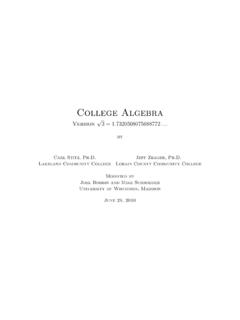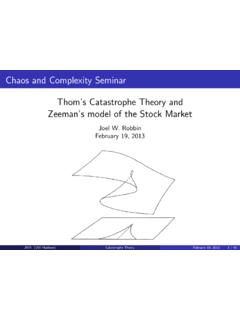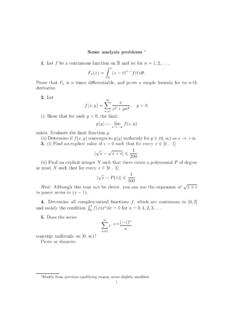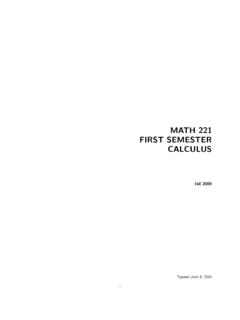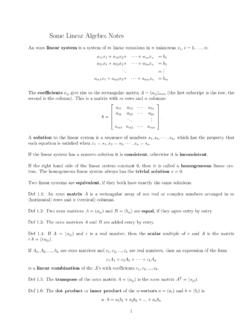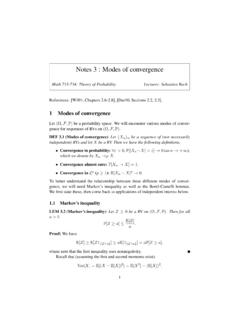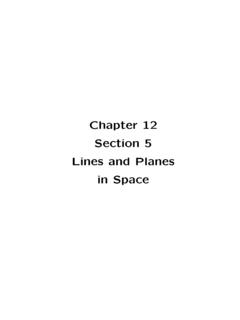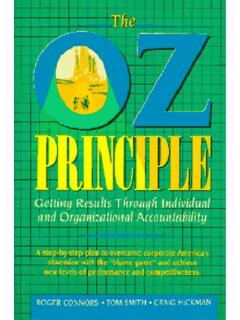Transcription of MATH 221 FIRST SEMESTER CALCULUS - Department of …
1 math 221. FIRST SEMESTER . CALCULUS . fall 2007. Typeset:December 11, 2007. 1. 2. math 221 1st SEMESTER CALCULUS Lecture notes version (Fall 2007). This is a self contained set of lecture notes for math 221. The notes were written by Sigurd Angenent, starting from an extensive collection of notes and problems compiled by Joel Robbin. The LATEX and Python files which were used to produce these notes are available at the following web site angenent/Free-Lecture-Notes They are meant to be freely available in the sense that free software is free. More precisely: Copyright (c) 2006 Sigurd B. Angenent. Permission is granted to copy, distribute and/or modify this document under the terms of the GNU Free Documentation License, Version or any later version published by the Free Software Foundation; with no Invariant Sections, no Front-Cover Texts, and no Back-Cover Texts.
2 A copy of the license is included in the section entitled GNU Free Documentation License . 3. Contents I. Numbers, Points, Lines and Curves 8. 1. What is a number? 8. Another reason to believe in 2 9. Why are real numbers called real? 10. Exercises 10. 2. The real number line and intervals 10. Intervals 11. Set notation 11. Exercises 12. 3. Sets of Points in the Plane 12. Cartesian Coordinates 12. Sets 12. Lines 13. Exercises 13. 4. Functions 14. Example: Find the domain and range of f (x) = 1/x2 14. Functions in real life 15. 5. The graph of a function 15. Vertical Line Property 15. Example 15. 6. Inverse functions and Implicit functions 16. Example 16. Another example: domain of an implicitly defined function 16. Example: the equation alone does not determine the function 17. Why use implicit functions?
3 17. Inverse functions 18. Examples 18. Inverse trigonometric functions 19. Exercises 19. II. Derivatives (1) 21. 7. The tangent to a curve 21. 8. An example tangent to a parabola 22. 9. Instantaneous velocity 23. 10. Rates of change 24. Exercises 24. III. Limits and Continuous Functions 25. 11. Informal definition of limits 25. Example 25. Example: substituting numbers to guess a limit 25. Example: Substituting numbers can suggest the wrong answer 26. Exercise 26. 12. The formal, authoritative, definition of limit 26. Show that limx 3 3x + 2 = 11 28. Show that limx 1 x2 = 1 29. Show that limx 4 1/x = 1/4 29. Exercises 30. 13. Variations on the limit theme 30. Left and right limits 30. 4. Limits at infinity. 30. Example Limit of 1/x 31. Example Limit of 1/x (again) 31. 14. Properties of the Limit 31.
4 15. Examples of limit computations 32. Find limx 2 x2 32. Try the examples and using the limit properties 33.. Example Find limx 2 x 33.. Example Find limx 2 x 34.. Example The derivative of x at x = 2. 34. Limit as x of rational functions 34. Another example with a rational function 35. 16. When limits fail to exist 35. The sign function near x = 0 35. The example of the backward sine 36. Trying to divide by zero using a limit 37. Using limit properties to show a limit does not exist 37. Limits at which don't exist 38. 17. What's in a name? 38. 18. Limits and Inequalities 39. A backward cosine sandwich 40. 19. Continuity 40. Polynomials are continuous 41. Rational functions are continuous 41. Some discontinuous functions 41. How to make functions discontinuous 41. Sandwich in a bow tie 42. 20. Substitution in Limits 42.
5 Compute limx 3 x3 3x2 + 2 42. Exercises 43. 21. Two Limits in Trigonometry 43. Exercises 45. IV. Derivatives (2) 47. 22. Derivatives Defined 47. Other notations 47. 23. Direct computation of derivatives 48. Example The derivative of f (x) = x2 is f 0 (x) = 2x 48. The derivative of g(x) = x is g 0 (x) = 1 48. The derivative of any constant function is zero 48. Derivative of xn for n = 1, 2, 3, .. 49. Differentiable implies Continuous 49. Some non-differentiable functions 50. Exercises 52. 24. The Differentiation Rules 52. Sum, product and quotient rules 53. Proof of the Sum Rule 53. Proof of the Product Rule 53. Proof of the Quotient Rule 54. A shorter, but not quite perfect derivation of the Quotient Rule 54. Differentiating a constant multiple of a function 54. Picture of the Product Rule 55. 25.
6 Differentiating powers of functions 55. 5. Product rule with more than one factor 55. The Power rule 56. The Power Rule for Negative Integer Exponents 56. The Power Rule for Rational Exponents 56. Derivative of xn for integer n 57. Example differentiate a polynomial 57. Example differentiate a rational function 57. Derivative of the square root 57. Exercises 57. 26. Higher Derivatives 59. The derivative is a function 59. Operator notation 59. Exercises 59. 27. Differentiating Trigonometric functions 60. Exercises 61. 28. The Chain Rule 62. Composition of functions 62. A real world example 62. Statement of the Chain Rule 63. FIRST example 64. Example where you really need the Chain Rule 65. The Power Rule and the Chain Rule 65. The volume of a growing yeast cell 65. A more complicated example 66. The Chain Rule and composing more than two functions 67.
7 Exercises 67. 29. Implicit differentiation 69. The recipe 69. Dealing with equations of the form F1 (x, y) = F2 (x, y) 69. Example Derivative of 4 1 x4 69. Another example 70. Derivatives of Arc Sine and Arc Tangent 71. Exercises on implicit differentiation 71. Exercises on rates of change 72. V. Graph Sketching and Max-Min Problems 75. 30. Tangent and Normal lines to a graph 75. 31. The intermediate value theorem 76. Example Square root of 2 76. Example The equation + sin = 2 76. Example Solving 1/x = 0 76. 32. Finding sign changes of a function 76. Example 77. 33. Increasing and decreasing functions 77. 34. Examples 79. Example: the parabola y = x2 79. Example: the hyperbola y = 1/x 80. Graph of a cubic function 80. A function whose tangent turns up and down infinitely often near the origin 81. 35.
8 Maxima and Minima 83. Where to find local maxima and minima 83. How to tell if a stationary point is a maximum, a minimum, or neither 84. Example local maxima and minima of f (x) = x3 x 84. 6. A stationary point that is neither a maximum nor a minimum 84. 36. Must there always be a maximum? 85. 37. Examples functions with and without maxima or minima 85. 38. General method for sketching the graph of a function 86. Example the graph of a rational function 87. 39. Convexity, Concavity and the Second Derivative 88. Example the cubic function f (x) = x3 x 89. The second derivative test 89. Example that cubic function again 89. When the second derivative test doesn't work 90. 40. Proofs of some of the theorems 90. Proof of the Mean Value Theorem 90. Proof of Theorem 91. Proof of Theorem 91. Exercises 91.
9 41. Optimization Problems 94. Example The rectangle with largest area and given perimeter 94. Exercises 95. VI. Exponentials and Logarithms 98. 42. Exponents 98. The trouble with powers of negative numbers 99. 43. Logarithms 100. 44. Properties of logarithms 100. 45. Graphs of exponential functions and logarithms 100. 46. The derivative of ax and the definition of e 101. 47. Derivatives of Logarithms 103. 48. Limits involving exponentials and logarithms 103. 49. Exponential growth and decay 104. Half time and doubling time 105. Determining X0 and k 105. Exercises 105. VII. The Integral 109. 50. Area under a Graph 109. 51. When f changes its sign 111. 52. The Fundamental Theorem of CALCULUS 111. Terminology 112. Exercises 112. 53. The indefinite integral 114. You can always check the answer 115. About +C 115.
10 Standard Integrals 116. 54. Properties of the Integral 116. 55. The definite integral as a function of its integration bounds 117. 56. Method of substitution 119. Example 119. Leibniz' notation for substitution 119. Substitution for definite integrals 120. Example of substitution in a definite integral 120. Exercises 121. 7. VIII. Applications of the integral 125. 57. Areas between graphs 125. Exercises 125. 58. Cavalieri's principle and volumes of solids 126. Example Volume of a pyramid 126. General case 127. Cavalieri's principle 128. Solids of revolution 129. 59. Examples of volumes of solids of revolution 130. Problem 1: Revolve R around the y-axis 130. Problem 2: Revolve R around the line x = 1 130. Problem 3: Revolve R around the line y = 2 131. 60. Volumes by cylindrical shells 134. Example The solid obtained by rotating R about the y-axis, again 135.
